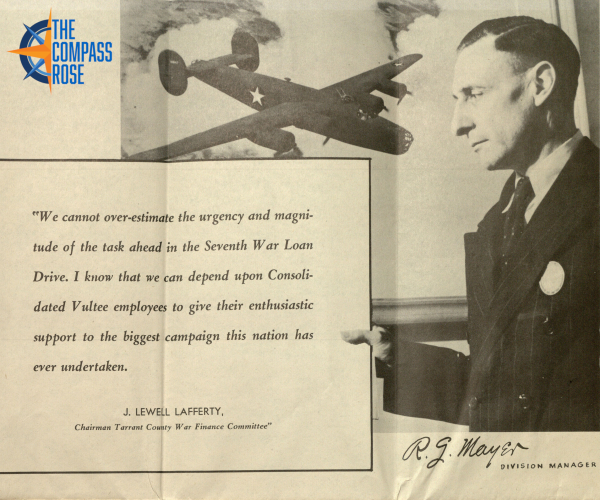
by Stephanie Luke


by Stephanie Luke
The purpose of The Compass Rose is to raise awareness of Special Collections' resources and to foster the use of these resources. The blog series also reports significant new programs, initiatives, and acquisitions of Special Collections.
North Texans were particularly active in the effort to support America during World War II. There are many items in The University of Texas at Arlington Libraries that illustrate how businesses and residents of the Dallas-Fort Worth area contributed to the cause. Of these, one of the more notable pieces is a solicitation for Convair employees to participate in the 7th War Loan Drive.

Convair solicits its employees to contribute to the 7th War Loan Drive.
While the U.S. government issues and sells bonds to raise funds for a variety of purposes, its sale of securities during times of war has perhaps been the most important. The first war bonds were sold in 1776 to support the Revolution, but they were also issued to raise funds for The Civil War, the Spanish-American War, World War I, and World War II. Of these, the bond campaigns of World War II are notable not only for their scope but also for their impact on the popular culture of the era. Although the country did not enter the war until December 1941, the sale of E Bonds (known as “defense bonds”) began in May 1941. After the attack on Pearl Harbor, the name of E Bonds was changed to “war savings bonds.”
During World War II, the government adopted two campaigns to raise funds for the war: loan drives and payroll deductions. Loan drives were familiar to the American public because they had been employed during World War I. During World War II, however, the government also worked with employers to establish payroll deductions. Through this program, employees could pledge a percentage of their income to the war effort and the company’s payroll departments would exchange that amount for bonds.

Convair's ad for its employees details how to participate in the 7th War Loan Drive.

The Fort Worth Star Telegram reports on Convair's fundraising goals for the 7th War Loan Drive. The goal was $2.5 million, which today would be approximately $35.8 million.
From 1942 to 1945, the U.S. government conducted eight War Loan Drives. The 7th Drive, which this pamphlet advertises, began only days after the surrender of Germany (“Victory in Europe Day”). It is apparent from the Fort Worth Star Telegram’s coverage of the drive that the Department of the Treasury feared that it would not meet its fundraising goal after the end of the war in Europe. The day before the 7th Drive commenced, Treasury Secretary Henry Morgenthau, Jr. reiterated President Harry S. Truman’s declaration that “our victory is but half won. The west is free, but the east is still in bondage,” and added that “The buying of bonds is an act of simple faith—faith in ourselves, faith in the men who fight for us, faith in the future of democracy.” Of the eight loan drives, however, the 7th Drive would prove to be the most successful, raising over $26 billion, equal to about $372 billion today.
This advertisement is directed to the employees of Consolidated Vultee Aircraft Corporation (generally known as Convair), a major manufacturer of military aircraft. In Fort Worth, Convair operated a mile-long facility on the west side of what is now Carswell Air Force Base and employed as many as 38,000 workers. One of its primary products was the B-24 Liberator heavy bomber, which saw service in all theaters of the war. Even before its entry into World War II, the U.S. government had established the Liberator Production Pool Program to produce a greater number of B-24 aircraft. Two of the five plants manufacturing and assembling this aircraft were in Texas: Convair (in Fort Worth) and North American Aircraft (in Dallas).

The Chairman of the Tarrant County War Finance Committee urges Convair employees to participate in the 7th War Loan Drive.
The Convair advertisement, in addition to the Fort Worth Star-Telegram’s coverage of the war loan drives, provide insight into how North Texans responded to the call for aid during the war. Within large businesses like Convair, competitions between divisions and shifts of employees were organized to see who could raise the most money. There were also challenges between rival companies over meeting fundraising goals. Pledging funds was a way of demonstrating one’s loyalty to the country and support for the men and women in uniform. Indeed, the April 29, 1943 edition of The Eagle, the Fort Worth plant’s weekly newsletter, reported on one employee whose weekly paycheck was 47 cents, with the remainder of her earnings being pledged to purchasing war bonds.
After the conclusion of World War II, Convair designed and constructed a number of military and civil aircraft. In 1953, Convair and its Fort Worth plant were sold to the General Dynamics corporation, and in 1994 to Lockheed Martin. The plant continues to operate as Air Force Plant 4.
Add new comment